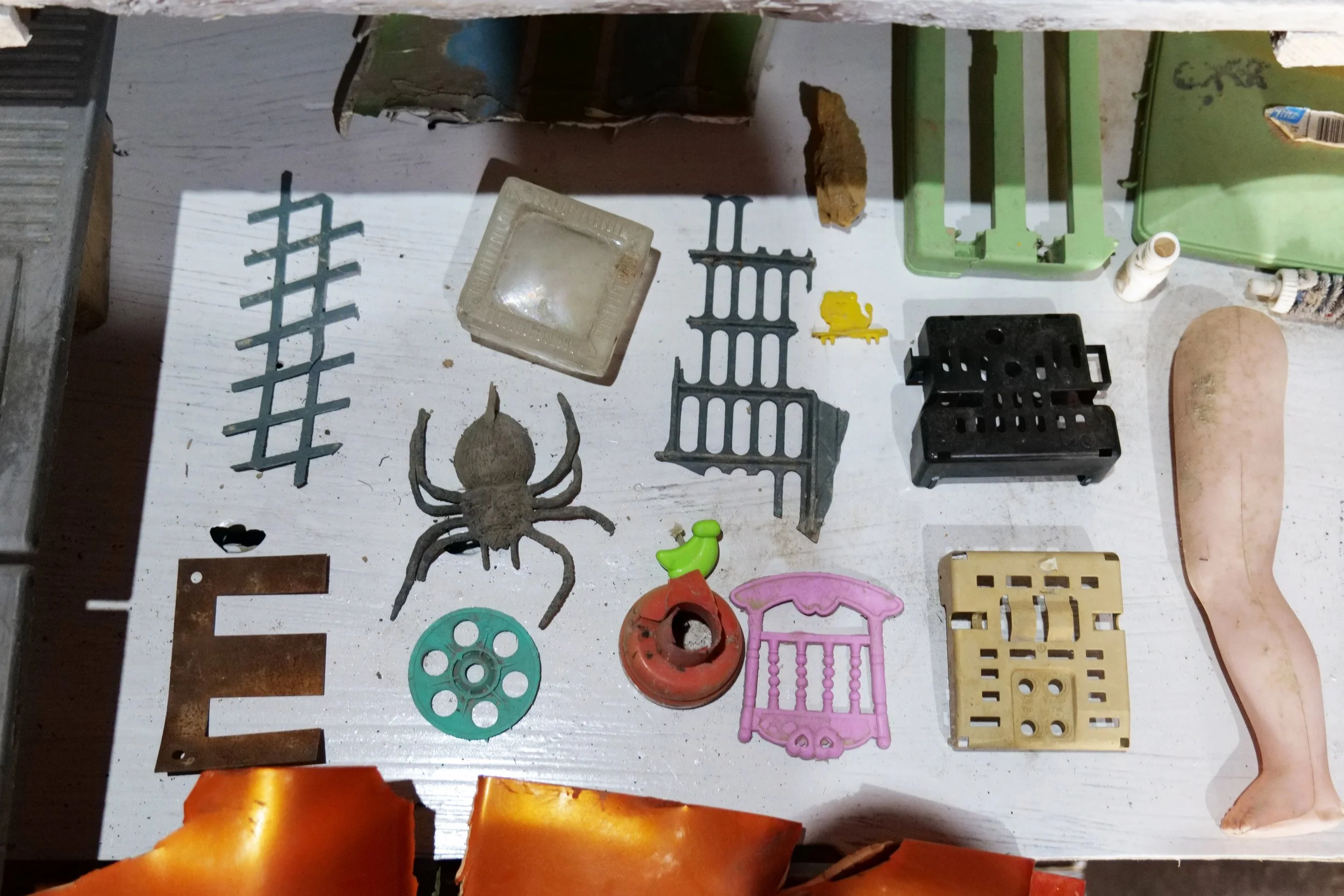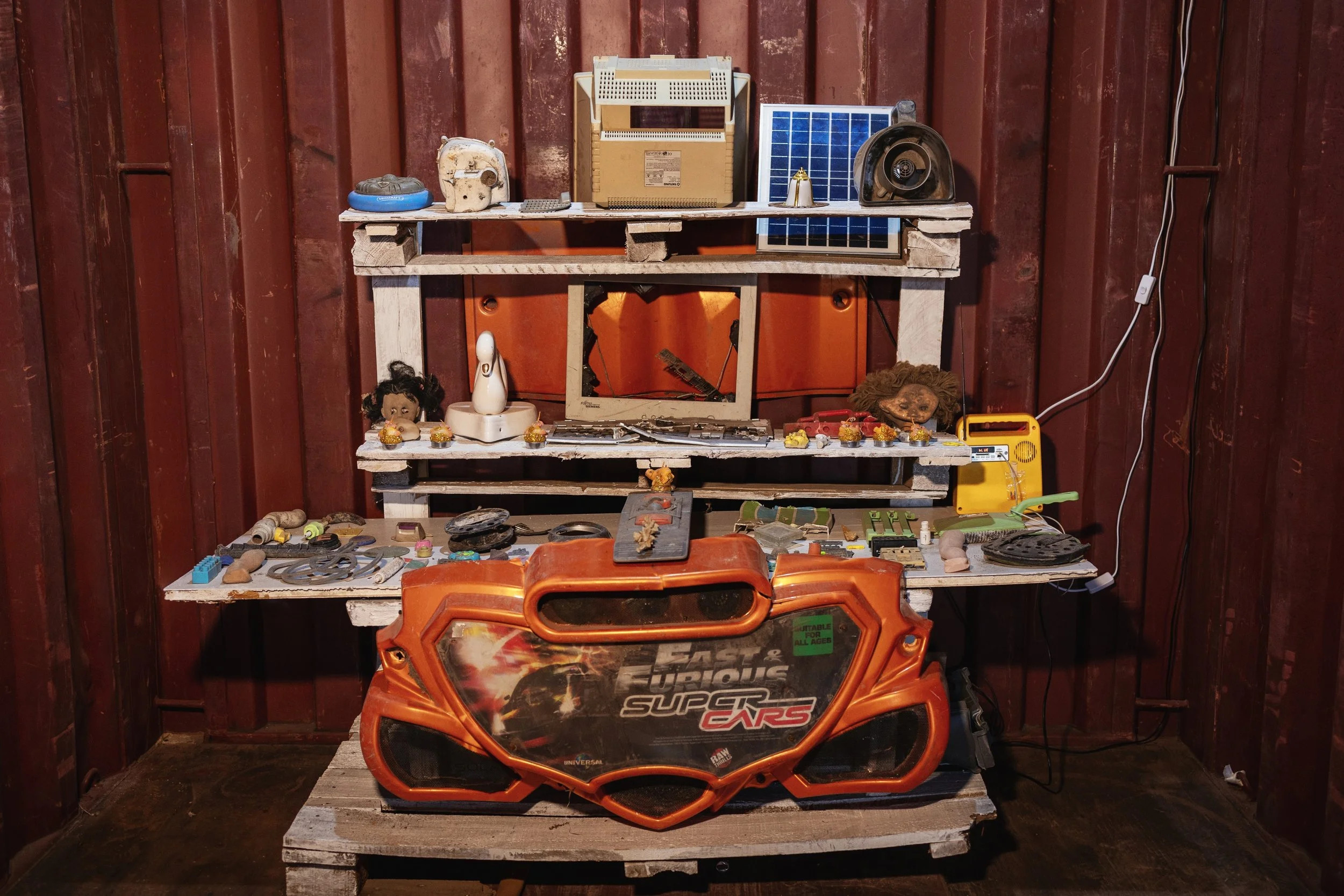TRASH MUSEUM, Bishkek, Kyrgyzstan, 2023
Trash Museum of Bishkek is a public museum dedicated to the study of trash located in a shipping container on an operating landfill in Bishkek, Kyrgyzstan. The Trash Musuem is a collaborative public artwork with the city residents living next to the city’s main landfill, which has received over 100 million tons of garbage since it began in 1976. The project explores the centuries-old history of garbage in Bishkek from the 1920s to the present day and is sited on a recently capped secrtion of the landfill. The Trash Musuem was the culmination of a month long residency by sTo Len as part of Interpreting the History of Pollution - Art Prospect & TRASH 5, a festival organized by Art Prospect, CEC ArtsLink, Tazar, and the Bishkek School of Contemporary Art. Through embedding in the daily operations of a landfill, Len created a public space in collaboration with local activists Bermet Borubaeva & Aimerim Tursalieva, artists and sanitation workers. The first exhibition opened on October 7th with displays of trash artifacts from the landfill picked by sTo Len, sanitation workers, and locals alongside photographs, historical material from the City Archive, prints, paintings, and sculptures.
The museum is now open to visitors once a month! Tours will be conducted by the co-organizer of the Trash Festival, Bermet Borubaeva, together with Samat Marsovich, senior accountant-operator at the Bishkek Sanitary Landfill and now co-curator of the Museum.
A zine about the experience and process is also AVAILABLE HERE
Trash is the autobiography of our existence that we all co-write every single day. The bulk of this history are the remnants of what sustained us or entertained us, from a simple pleasure to an absolute necessity. Even the most conscious of us leave a trail of imprints on this planet from the moment we are born. Follow them and you will discover a life path interwoven with the products and technology of the day. It is easy to be overwhelmed by this essential ritual of subtraction that both defines our private life and our shared public spaces, thus it often resides in the shadows, unseen, ignored, banished “away” for others to deal with.
“Away” however is always a real place populated with real people. In Bishkek, that place is the landfill that is often referred to as the Poligon or the Hill, located in the most northern part of the city, near a neighborhood called Altyn-Kazyk. Everything comes there by truck or donkey in an ever-flowing single stream of trash 24 hours a day; from food waste to paper, plastic, metal, dead animals, and sometimes live ones too. There is surprisingly a lot of life amidst the trash mountain heaps. I observed packs of wild dogs, stray cats, crows, horses, and even some chicks freshly hatched from their disposed eggs. I heard horrifying tales of dead bodies and abandoned newborn babies, chemical waste, and ever-raging trash fires that would sometimes self-ignite due to the methane gas oozing out but thankfully this seemed to be of the (not so distant) past. Just as recently as May 2023, the landfill was openly burning the mixed garbage which of course created horribly toxic conditions for everyone working and living here.
In 2022, Bishkek’s air quality was ranked second worst in the world and its main culprits were the landfill, coal usage and vehicle emissions (catalytic converters are scarce.) So the fact that the landfill had recently stopped burning was a really big deal. The local artists and activists that I had been in contact with have been working on these issues for over a decade and their hard work was beginning to pay off. A compassionate new landfill director enabled these changes and so when I brought up the idea of creating a Trash Museum at the landfill, everyone seemed to be on board. When I arrived to town, things were already in full swing. A shipping container was to be placed on site at the landfill for us to use and the first time I visited, we watched as it was getting craned into place. Immediately following this celebratory moment, a local news blog wrote about the project and subsequently some government officials got wind of this trashy idea for a museum and effectively put a stop to our project. In the spirit of not taking no for an answer, we naturally decided to fight this decision and began to show up regularly at City Hall and other various city offices to find the right people to talk to. One person would lead to another person and then another, all as unlikely as an ally as the next but through some sincere conversations (and gifts of NY Sanitation swag), we were beginning to change their minds. It was an incredible thing to witness, the change in perspective as we presented our case.
The idea of mixing the arts with municipal waste management is still radical in most parts of the world and so it wasn’t particularly surprising that this idea didn’t initially go over well. Trash is also such a touchy subject because no one really wants to think about it nor promote actually going to see it lest something goes horribly wrong. Once they realized that we were not trying to exploit or endanger anyone, or attempt to make them look bad either, I think they could see this as an opportunity for a positive and educational partnership with public outreach that they don’t normally get to have. After two weeks, we officially got the green light. It was a momentous win, not just for this project but for the potential of creating more collaborative art projects with city government. While we were battling for this victory, we also made sure to hit the municipal archives for records on the landfill and trash in Bishkek. That was an experience unto itself as we dug into the musty card catalogs of their Soviet-era records, snapping cellphone pics of documents and getting some scans of the black and white photos depicting the Brick Factory that was at the landfill site prior to the trash. Needless to say, they were a little baffled by our garbage-related requests and I was surprised at how little there seem to be. Were these records thrown out with the trash too?
With the City Hall win under our belt, I set my sights on the site itself and began going to the landfill on a daily basis. I was initially met with some side-long glances by the locals which is to be expected but I felt like I rather quickly became a regular character among the group. I particularly grew fond of Almas, the deputy director of the landfill, who invited me for tea and soup one afternoon. Sitting around armed with Google Translate, we became fast friends as we spoke of our lives, jobs, and common interests in trash. It was so great to be incredibly far away from my life in NY and yet feel right at home with Almas and his crew as we sat in their kitchen at the landfill. The more I showed up, the more I learned and took in. I asked them to add objects they had found while on the job to the “permanent collection” and received bowling balls, candles, a ceramic crane, a Boss wristwatch, and a light up toy that still worked and showed a cityscape whizzing by. I began picking up lots of objects myself as my eyes had finally adjusted to be able to discern what was really out there. At first, it is just an overwhelming sea of colors and textures, mangled together through some kind of twisted fate, weathered by the world and encrusted with the land that it would soon be buried into. I recalled the first time I had gone to the desert in California and was able to train my eyes to perceive the full bandwidth of color and life hiding in plain sight in the seemingly blank landscape.
This was no different. I even became fond of certain sections of the landfill; the patterned textile mountain of fabric scraps and zippers, the digital detritus dump of glistening computer insides, and the party zone with glittery costumes, balloons, and lost parts to amusement park rides. Where there is pain, one can still find joy. I think my default is to find the humor and levity in sites like this otherwise, it is all just too depressing. Visitors began stopping by the shipping container as they traveled through the landfill to see what I was up to. One elderly man took a particularly liking to me and immediately stuck his kalpak (the white felt hats Kyrgyz men often wear) on my head and proceeded to mimic a cowboy standoff. This was entertaining until he wouldn’t let me get back to work and followed me around saying “Whoa, take ‘er easy there, Pilgrim,” quoting an old John Wayne movie over and over. I asked Almas for photos and he gave me some stunning portraits taken by the workers themselves which we printed out and put up on the walls. One day out of nowhere a guy showed up and introduced himself as Mr. Sam and told me that he wanted to help. I mentioned that a local artist, Aziz Sedek, was interested in creating a bowling game with recycled bottles and the Earth as the ball and he immediately went to work, bringing several bulldozer loads of bricks that we could use to create a lane and even a patio for hanging out. Mr. Sam wound up being an account for the landfill and one of my best friends that I met. (He is now a curator at the Trash Museum)
We opened the Trash Museum of Bishkek on October 7th 2023 as part of the Trash 5 Festival, an incredibly ambitious month-long event that brought together dozens of artists, activists, and environmentalists to create work that responded to Bishkek’s waste-related issues. Organized by the Bishkek School of Contemporary Art, Bazar, Art Prospect, and CEC Artslink, this was the perfect venue for something like a Trash Museum to be created.
The Trash Museum of Bishkek is located at the site of the still operating Bishkek Sanitary Landfill and will continue to be open monthly and by appointment. The inaugural exhibition, Interpreting the History of Trash, examines what we throw away, where it all goes, and who deals with it everyday by putting things into a historical context. Using archival material, photographs, artwork, and trash objects, the Trash Museum aims to initiate this important conversation and then from there we hope to implement a change in the minds of the public and city officials alike. We celebrate that the poligon has stopped burning and look back at the history of pollution in Bishkek so we can think about how to move forward. We hope that this Museum can be the source of a collective memory and grow into an evolving archive about the trash issues we currently face today.
Why a Museum?
Typically, a museum is a sacred place for objects of value. We go to museums to contemplate important historical artifacts or artworks. By creating a museum for trash, we give value to the study of garbage and declare its’ importance to our lives. Placing a piece of trash on a pedestal gives us a new perspective and allows us to examine our own relationships to the objects that we use and throw away everyday,
Who is this place for?
All of us! Everyone is invited to visit and add to our collection of objects, books, artwork, artifacts, workshops, and ideas. Let’s co-create this museum to give visibility to our waste and why we must produce less trash. How can a museum share the lived experience of a people and a landscape through an exhibition? How can we work together to make things better? Let’s continue this conversation…..
sTo Len, 2023























